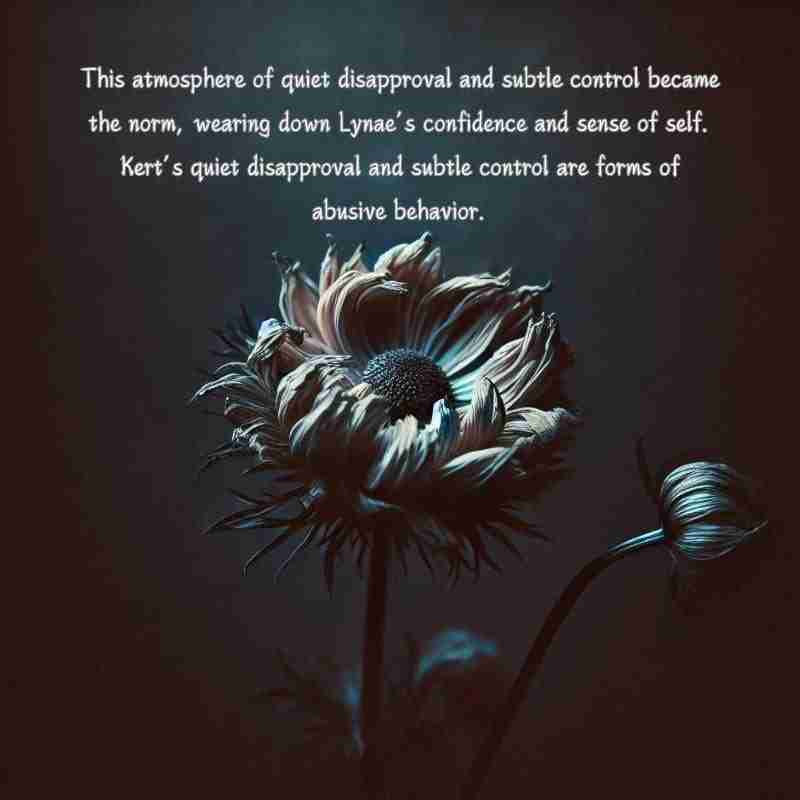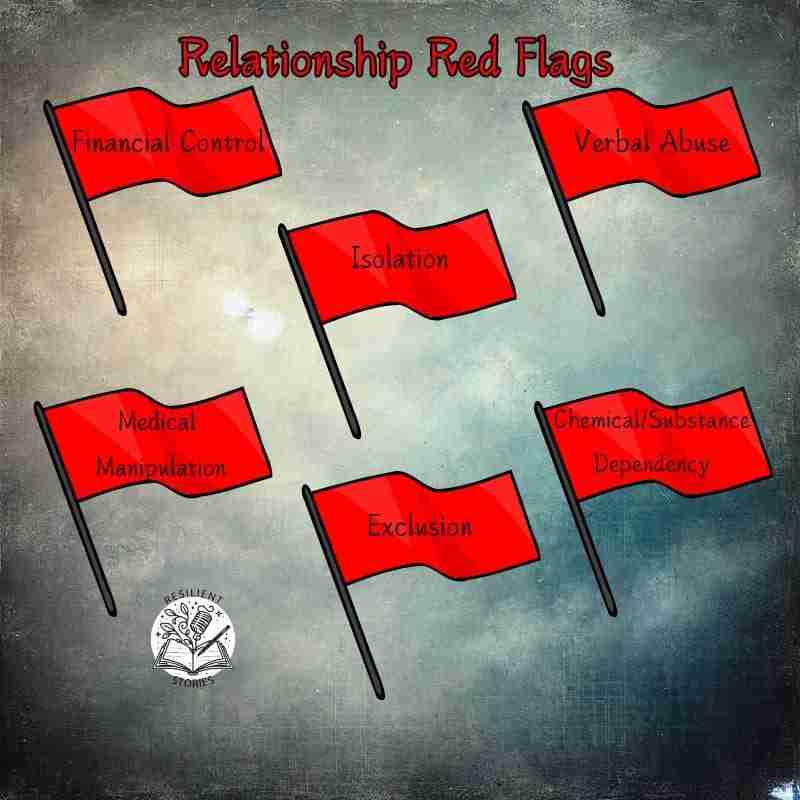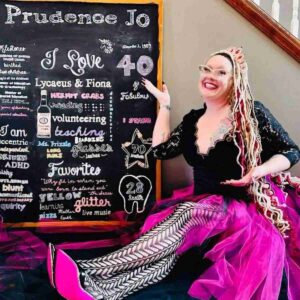Story contributed by Lynae Dolechek
Sitting across from Lynae, I initially anticipated this personal interview to be a tale of enduring love. The kind that weathers life’s storms and emerges stronger. Instead, Lynae’s story unfolded as a narrative of coercive control that spanned decades.
Initially, she, too, genuinely believed it was a love story where she’d live happily ever after.
This is her story—a story that needs to be told to illuminate the insidious nature of coercive control. She hopes it will inspire others to recognize and break free from similar circumstances.
It will help answer the question, “What is coercive control?” and demonstrate warning signs in an intimate or family relationship.
Coercive Control: Early Days, Love, and Illusions of a Protective and Caring Partner
When Lynae first met her future husband in the early 80s, he was with his new bride. She was on a date with his cousin. His wife was disinterested in any conversation with the group. She just picked at the pizza toppings in boredom.
Kert barely looked at or spoke to Lynae as he was busy chatting with his cousin.
Lynae, however, was enamored with Kert despite the circumstances. She promised God that if she got a chance with Kert in the future, she’d be with him for the rest of her life.
She’d heard that Kert’s recent marriage was already on the rocks, so it was not an impossible thought. However, she truly doubted she would ever see him again.
Little did she know that her silent prayer would be answered later that same year when Kert discovered his wife with her ex at a dance. Kert moved out immediately and started paperwork to end their seven-month marriage.
That August, they met again. Their courtship was filled with movie nights and shared popcorn, late-night conversations about everything, and spending time with their families.
Lynae Started to Become an Extension of Kert
Her life started revolving around Kert, his schedule, and his interests. While she happily waited to see him again.
After dating for four years, they married on June 4, 1988, under the searing 104-degree heat on her grandma’s porch in front of a yard full of guests. Despite melting candles and frosting, it was a day of promise and commitment.
Their lives began in a mobile home, bought for $1,700, where they navigated the first six years of marriage. The 1994 was filled with change. Their first son was born shortly before Kert graduated from college. They also relocated for Kert’s job and then moved again when they bought their dream home shortly after that.
Kert’s career as a mechanical engineer took precedence, with Lynae supporting his ambitions, often at the cost of her own identity.
Financial Control: The Start of Financial Abuse
From the beginning, Kert displayed signs of controlling behavior in their relationship. He meticulously monitored their finances, keeping an exhaustive list of every purchase on an Excel sheet.
He would ask Lynae for each receipt to record expenses, scrutinizing everything from her makeup to items purchased for the boys.
Although he didn’t initially limit her access to money, his constant questioning and analysis of their spending created an atmosphere in which Lynae was not allowed to make any financial decisions. She stressed about spending money in general.
Kert’s meticulous monitoring of finances is a form of financial abuse aimed at restricting Lynae’s freedom and autonomy.
Lynae thought Kert was managing their finances to care for the family, a belief she held for many years. It wasn’t until much later that she recognized his behavior as a means of control stemming from his own insecurities.
To avoid conflict, she became extremely careful with money, rarely using credit cards and refraining from unnecessary purchases. She felt compelled to monitor her own spending closely because she knew Kert would notice every transaction.
Lynae’s Decision Making Ability Was Slowly Stripped Away
As Kert’s career advanced, so did his subtle control over their lives. He insisted on making all the decisions, both big and small, leaving Lynae feeling incapable of making even simple choices. This financial control was coupled with a quiet disapproval that Lynae found increasingly difficult to navigate.

There was no yelling, just a pervasive sense that she always fell short of Kert’s expectations. If she asked him if he was upset or mad, he would deny it. She could tell he was lying. Years later, during marriage counseling, Kert admitted that he often lied to avoid explaining himself.
Lynae’s life became a series of carefully monitored activities. She constantly second-guessed her choices to avoid Kert’s disapproval. Soon she became paralyzed when it was time for her to make any kind of decision.
He discouraged her from socializing, often making her feel guilty for wanting to spend time with friends. His jealousy and possessiveness extended to monitoring her time and questioning how she spent her days.
This control wasn’t overtly forceful. It was subtle, making it all the more difficult for Lynae to recognize it for what it was.
Isolation and Quiet Disapproval: Living Under Subtle Coercive Control
Kert’s coercive behavior extended beyond finances. Lynae began to feel isolated as he gradually limited her social interactions. Though it wasn’t through direct orders, his subtle tactics made her feel guilty for wanting to spend time away from him.
Over time, she stopped making plans with friends because of the guilt he would instill in her for wanting to be apart from him.
Lynae also noticed that Kert’s disapproval was always quiet but palpable. There were no loud arguments or obvious confrontations. Instead, his disapproval came through in a quiet, unspoken way that left Lynae constantly anxious about upsetting him.
She found herself walking on eggshells, not out of fear of physical violence, but out of a deep-seated worry about disappointing him. She knew he was lying when he said he wasn’t upset. Yet, she went along with it to avoid further conflict.
This atmosphere of quiet disapproval and subtle control became the norm, wearing down Lynae’s confidence and sense of self. Kert’s quiet disapproval and subtle control are forms of abusive behavior.

Throughout their marriage, Lynae repeatedly tried to save their relationship by encouraging Kert to attend marriage counseling.
Attempting to Get Help and Guidance
Over ten years, they saw four different counselors. but Kert often missed sessions due to “work crises” and frequently complained that the counselors were taking Lynae’s side. He had hoped they would “fix” her instead of addressing the issues in their marriage.
Despite these setbacks, Lynae persisted, even seeing a fifth counselor alone. When the counselor requested to meet Kert for a more balanced perspective, he agreed but expressed frustration, expecting immediate changes after just a few visits.
This led to another round of counseling. Kert’s inconsistent attendance and reluctance to continue paying for sessions eventually led them to quit.
After their separation in October 2015, Kert suggested they see yet another counselor. Lynae reluctantly agreed, knowing she would be blamed for not “trying” to save the marriage, even though she had been trying for years.
However, after a few sessions, Lynae realized that she no longer wanted to save what she saw as a sinking ship and decided to pursue a divorce.
Medical Challenges and Escalating Coercive Control
Kert’s health issues added another layer of complexity to their relationship. He suffered from chronic headaches and underwent multiple sinus surgeries in an attempt to find relief. These medical challenges became another arena where Kert’s controlling tendencies emerged.
He meticulously managed his medical care, going as far as creating a PowerPoint presentation to convince his doctor to increase his pain medication dosage. This detailed management is an example of coercive abuse.
Lynae stood by his side through all of this, but she began to notice how his focus on his own needs further overshadowed her well-being and that of their children.

Like many women, Lynae put Kert’s wants and desires above her basic needs, often at the expense of her energy and attention. With Kert absorbed in his own concerns, she was left to care for their children and often hosted their friends, who frequently gathered at their home.
Losing Herself a Little More Each Day
As Kert’s health deteriorated, so did his behavior. He insisted on working even while heavily medicated, driven by a fear of losing his job. A fear that, while deeply felt, may not have been entirely realistic given his reputation as one of the company’s best and most respected mechanical engineers.
Kert’s behavior included controlling aspects, such as managing his medical care, micromanaging household chores, and other daily tasks. He would give Lynae lists to complete and then grill her when she didn’t complete everything on them.
After he stopped using pain medications, Kert began drinking during his 15-minute breaks and lunch to cope with life’s stresses, further complicating his behavior and worsening the strain on their relationship, which would last about another 5 years.
Lynae recalled an instance when sedated before emergency surgery, Kert obsessively measured hospital bed rails and wanted to contact colleagues about work details. His identity was so intertwined with his job that he couldn’t disconnect, even in the face of severe health issues.
This period was exhausting for Lynae as she managed the household, cared for their children, and catered to Kert’s relentless needs. Despite her best efforts to support him, Kert’s behavior grew increasingly erratic, particularly after he began drinking heavily in 2011.
Exclusion and Alcohol: The Escalation of Subtle Abuse
Kert’s drinking marked a significant escalation in his controlling behavior. He began to exclude Lynae from family activities, taking their sons on outings without informing her, creating a divide within the family.
He also refused to attend events that were important to Lynae. His financial threats and tight control over finances deepened her isolation.

Lynae rarely used credit cards because of Kert’s rigorous monitoring of their spending.
Despite these warning signs, she felt bound by her vows and believed that she needed to uphold the marriage.
Her sense of duty, shaped by a family history of enduring relationships, kept her in this coercive relationship long after the love had faded.
She didn’t tell Kert’s family about his drinking, feeling the need to protect his reputation. She feared they would blame her for not doing enough to help him, and as a result, they didn’t believe he had a drinking problem after his death.
Living in Uncertainty: The Reality of Subtle Coercive Control
Lynae’s support system eroded over time as Kert’s control over her life became more all-encompassing. He monitored her emails and text messages, often accusing her of infidelity without any evidence. She would not get defensive, attributing his behavior to residual trust issues from what happened with his ex.
Lynae began to feel like her world was shrinking, confined to the boundaries Kert had set. Her experience of coercive control shaped Lynae’s daily reality.
The daily reality of living under coercive control meant constant uncertainty. Lynae found herself unable to make even the simplest decisions without fearing Kert’s reaction. She recalled an instance where she was paralyzed by the thought of buying a different brand of pasta, knowing he might disapprove.
She became so anxious that she couldn’t shop without him. When they shopped together, he made all the decisions and usually ignored her input. During the last year of their marriage, he didn’t let Lynae shop with him or help him cook.
As Kert’s drinking increased, his behavior became more unpredictable. He didn’t have loud outbursts but would express his disapproval in subtle, insidious ways that left Lynae feeling confused and disoriented.
Their conversations became circular and unproductive, with Kert often talking in a way that made Lynae feel like she was missing the point.
These conversations felt like interrogations, where he tried to pound a point into her brain, leaving her feeling increasingly disconnected and unsure of what was happening. Kert’s accusations and monitoring affected their family relationship, further complicating the dynamics between them.
Recognizing the Red Flags: Signs of Subtle Abuse

Lynae’s story is clearly not one single act but several subtle red flags of coercive control and abuse:
Financial Control: Kert’s meticulous monitoring of finances, strict budget, and limiting access to money created a sense of dependency and fear in Lynae. This financial control is one of many abusive behaviors.
Isolation: Lynae’s gradual separation from friends and family was orchestrated through subtle guilt and disapproval.
Verbal Abuse: Though not overt, Kert’s quiet disapproval and subtle put-downs eroded Lynae’s self-esteem over time.
Medical Manipulation: Kert’s control extended to his medical treatments, where he manipulated doctors to suit his needs.
Exclusion: Lynae was increasingly excluded from family activities, deepening her isolation and sense of alienation.
Dependency on Alcohol: Kert’s drinking problem escalated his abusive behavior, making the environment more unpredictable and stressful for Lynae.
Breaking Point: The Tragic End of a Domestic Abuse Relationship
In 2015, the strain on Lynae and Kert’s relationship became unbearable. The years of coercive control, compounded by Kert’s escalating alcohol abuse, reached a tragic conclusion on July 16, 2016.
Eight months after a particularly unproductive conversation where Kert told Lynae to “leave and get out,” he died in a car accident while driving under the influence. His blood alcohol concentration (BAC) was 0.222, far above the legal limit.
Kert’s car, a 1970 Duster with a big block Mopar engine he had once raced on quarter-mile tracks, became the scene of this devastating accident. On the night of his death, Kert had been driving around town with his girlfriend, Nicki, and a coworker, Kendra.
After getting a flat tire, he went home to swap the slicks with tires from another vehicle, intending to drive the Duster home instead of having it towed. Despite promising their youngest son that he would bring the car straight home and avoid the bars, Kert returned to drinking and driving.
Kert was last seen doing a burnout in front of a bar before heading down the road, where he, Nicki, and Kendra would all lose their lives. While showing off the Duster’s speed, the car skidded off the road, flipping multiple times before landing on its side.

Coping With the Immediate Aftermath
Tragically, the vehicle burst into flames, and the two women were trapped inside, screaming for help as the fire engulfed them. Their bodies were so badly burned that they could only be identified through dental records. Kert’s body was found disfigured.
They could only identify him by his wallet.
Lynae learned of Kert’s death when her oldest son called her at 4:30 a.m., screaming, “Dad is dead!” Initially thinking he had dropped dead at home, Lynae was shocked to learn the details of the accident.
At the time of this phone call, Lynae was unsure who the other car occupants were. For a moment, she thought it was her other son and either his girlfriend or best friend.
The news that Kert had died alongside two women, neither of whom Lynae knew, added to the horror and confusion of that morning.
In a frenzy, Lynae informed her family and friends. Lynae’s parents drove her back to Kalispell, an agonizing 7-hour journey before finally stopping at the accident site. Shortly after, they arrived at the house, where loved ones had already begun preparing for the flood of visitors.
The days that followed were a blur of funeral arrangements and grief. Lynae, separated from Kert at the time of his death, offered for his mother to write the obituary—a decision she later wished she had handled differently.
Her mother-in-law was a wonderful woman, but this was yet another instance where Lynae felt she had to hand over decision-making to someone else. The experience was a stark reminder of the destructive power of Kert’s coercive control, which had persisted even in death.
Seeking Support: The Path to Recovery
In the aftermath of Kert’s death, Lynae began the difficult journey of reclaiming her life. She recognized that she should have sought support services sooner, but she was fortunate to have an incredible network of friends who were there for her 24/7.
Their unwavering support helped her rebuild her identity beyond being Kert’s wife and the mother of their children. Lynae reconnected with friends and family, discovered new hobbies, and worked towards establishing her financial independence.
She is certain that she wouldn’t have survived without the love and support of these friends, who remain by her side even years later.
Lynae’s story underscores the critical need for awareness and support services for victims of domestic abuse. It highlights how abusers use subtle tactics to control their victims and the profound impact this control can have on a person’s life.
By sharing her experience, Lynae hopes to inspire others to seek help, recognize the signs of coercive control, and reclaim their autonomy and human rights.
A Story of Resilience and Hope
Lynae’s journey is a testament to the strength and resilience of individuals who endure and survive coercive control.
Her story sheds light on the subtle and overt tactics of abusers, the importance of recognizing red flags, and the need for a robust support system. It serves as an inspiration for others to take the courageous step towards freedom and healing.
By sharing Lynae’s story, we aim to raise awareness about coercive control and domestic abuse, encouraging victims to seek help and support.
If you or someone you know is experiencing coercive control or domestic violence, reach out to local support services or national helplines. Remember, you are not alone, and there is help available.
Have you had an intimate partner treat you this way? Let us know how it impacted your day to day activities and daily life in the comment section.





























I commend Lynae for having the courage to share. The more stories I read, the more I realize most people have a story (or many) of surviving some very tough thing. We are all having “the human experience”. When we share our stories, we do it together. <3
We could not agree more! In my heart, I believe that is what is going to make this space a community for all. A safe place where voices matter. Each of us has a story, and we can learn from each other while we heal and uplift one another. Thanks for commenting and being a part of our community!
Recognizing flags can be difficult when you believe you are in love and are loved back. Lynae should be proud of herself for recognizing the way to save herself and her self respect.
Absolutely! Lynae is a beautiful person who deserves all the best in the world! Thanks for leaving a comment.